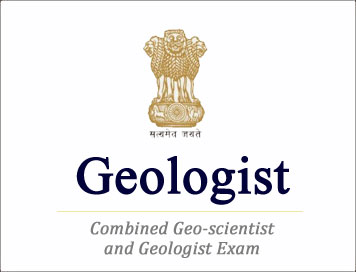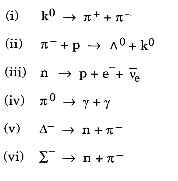(FREE) UPSC Current Affairs 2025 PDF
NEW! The Gist (SEP-2025) | E-BOOKS
(Download) UPSC: Geologist Examination Papers-2020 (Geo-Physics Paper - 2)

(Download) UPSC: Geologist Main Examination Papers-2020
(Geo-Physics Paper-2)
Exam Name : UPSC Geo-Scientist and Geologist Main Exam
Subject : UPSC Geo-Scientist and Geologist Main Exam Papers 2020 : Geo-Physics Paper- 2
Year : 2020
Geo-Physics Paper - 2
- Time Allowed : Three Hours
- Maximum Marks : 200
SECTION A
Q1. (a) Vertical electrical sounding data recorded using Schlumberger electrode configuration shows a three-layer H-type apparent resistivity curve. This data was interpreted using partial curve matching technique. Resistivity and thicknesses of first two layers were estimated as

Calculate the effective resistivity and effective thickness of a single homogeneous and isotropic layer obtained by replacing the first two layers into one single layer.
(b) What do you understand by the terms static self-potential and pseudo-static self-potential used in SP log ? Explain positive, negative and zero SP responses in terms of resistivity of formation water and resistivity of mud filtrate.
(c) In time-domain electromagnetic sounding, decay response is recorded on the surface of uniform earth with constant conductivity. Draw neat schematic diagrams showing the characteristics of decay curve as a function of time, in early, intermediate and late time zones. How does decay response vary with increase and decrease of conductivity of uniform half-space ?
(d) Illustrate with sketches the nature of Bouguer and free-air gravity anomaly when a structure or region is 100%, 50% and 0% isostatically compensated.
(e) If you took a gravimeter 1 km down a mine in rocks of density 2-4 gm/cm”, how much would be the change in gravity compared to the surface ?
Q2. (a) What are the differences between stable and unstable types of gravimeter ? How is sensitivity of unstable gravimeter increased in comparison to stable type gravimeter ? Show mathematically.
(b) Discuss in detail “Reduction to Pole' and “Pseudogravity Transformation" methods for magnetic survey data.
Q3. (a) Multi-electrodes resistivity imaging data were recorded using 20 number of electrodes deployed along a line at constant inter-electrode spacing of 1 m. All electrodes were connected to resistivity imaging system through multi-core cable. Answer the following questions :
(i) If two electrodes array is used for measurement, calculate the total number of independent data points recorded.
(ii) If the Wenner array is used for measurement, calculate total number of depth levels along with number of independent data points in each depth level.
(b) Show that magnetotelluric impedance over the surface of uniform earth with constant conductivity increases with frequency of plane electromagnetic wave propagating vertically downward in the earth, whereas phase of impedance is independent of frequency and conductivity of uniform earth.
(c) What do you understand by Transverse Electric (TE) and Transverse Magnetic (TM) modes used in two-dimensional magnetotelluric (MT) modelling ? How does MT field split in TE and TM modes ? Explain your answer with the help of Maxwell's equations. Draw neat schematic diagrams showing TE and TM modes apparent resistivity responses along a profile passing through vertical resistivity discontinuity. Also explain the features of apparent resistivity curve for TE and TM modes.
Q4. (a) Taking Hooke's law, Young's modulus and Poisson's ratio as a starting point, derive from the first principles an expression relating the above elastic modulus parameters using an appropriate set of stresses in the Cartesian coordinate system.
(b) What are the main purposes of stacking ? Describe the Common Depth Point (CDP) Stacking.
(c) How does a migrated reflection seismic section differ from an unmigrated one ?
Q5. (a) (i) Obtain an expression for apparent resistivity for normal electrode logging device, using appropriate form of potential, V, due to current, I, injected through an electrode placed in a uniform whole space at a distance r from the measuring electrode.
(ii) A normal electrode device is placed in a medium composed of three homogeneous and isotropic zones centered around the current electrode, A. The first zone extends spherically to a radius of 80 cm and has a resistivity of 20 Nm. The second zone extends spherically to a radius of 1.62 m and has a resistivity of 5 m. The third zone extends infinitely beyond the second zone and has resistivity of 1 2m. Calculate voltage and apparent resistivity between electrode M and a distant electrode N for a 1 A current and normal electrode spacing AM = 40 cm.
(b) (i)What do you understand by the term 'Cycle Skipping in sonic logging ? Why can sonic log response not be used to estimate true porosity of formation in case of very low (< 5%) and very high (> 50%) porosity ?
(ii) Compressional wave velocities in subsurface formation vary between 3050 m/s and 7000 m/s, while in drilling fluid it is 1830 m/s. What is the variation in critical angle in degrees for these extreme velocities ? In a sonic logging device, if the
smitter-receiver pair is separated by 90 cm centered in a 26 cm diameter borehole, calculate the actual distance of formation traversed by a first arrival compressional wave, in case of largest critical angle.
SECTION B
Q6. (a) Lagrangian of a system is given by L(x, y, x, y) =1 m(x2 + y2)- 1 k (x2 + y2 + xy).
2 2
m and k are constants. Find the frequencies of normal modes of the system.
(b). Find the threshold kinetic energy of the incident proton in the laboratory frame for the process :

(c) A drunk starts out from lamp post in the middle of a street taking steps of equal length either to the right or to the left with equal probability. What is the probability that the man will be at the lamp post again after taking
(i) 2N and (ii) 2N + 1 steps ?
(d) Describe the spectrum of hydrogen atom. Explain its hyperfine structure with the help of L-S and J-J couplings.
(e) Describe the Yukawa's nuclear potential model for nucleon-nucleon interaction and also give the basic characteristics of nuclear forces.
Q7. (a) The motion of a particle in one dimension is described by the Lagrangian L = 1 (x2 – x2], in suitable units. Calculate the value of the action along the path from x = 0, at t = 0 to x = xo, at t = to.
2
(b) A particle of mass m is subjected to the one-dimensional potential V(x) = x3 + 3 x2 – 18x + 7. Find the frequency of small oscillation about the stable equilibrium of the particle.
2
(c) Two events separated by a distance 9 X 109 m along X-axis are simultaneous in one inertial frame. Find the time interval between these two events in a frame moving with a constant speed 0.8 c(where c is the speed of light) along x-axis, with respect to the first inertial frame.
Q8. (a) What is Raman effect ? How can a Raman spectrum be used to investigate the structural information of molecules ?
(b) How can electron diffraction pattern of TEM be used to determine the crystal structure of a material ?
(c) What is Nuclear Magnetic Resonance ? Describe the principle and working of an NMR spectrometer.
Q9. (a) Evaluate the partition function of a system of N non-interacting one-dimensional quantum simple harmonic oscillators. Hence, calculate the entropy and specific heat of the system. Show that quantum mechanical oscillators do not follow the Equipartition theorem.
(b) A one-dimensional simple harmonic oscillator with mass m, angular frequency w is having energy between E4 and E2 with E2 > E1. Calculate the phase space area available to the simple harmonic oscillator. Mark the area in a schematic phase space diagram.
Q10. (a) What are the experimental evidences and observations that support Nuclear Shell model ? Describe the shell model of a nucleus and its limitations.
(b) What is the meaning of parity violation ? Briefly discuss the Co-60 experiment to demonstrate parity violation in weak interaction.
(c) What are the different fundamental interactions of nature ? Mention few characteristics for each of them. Name the interactions via which the following processes are occurring :


